Japanese Missionary Couple Researches 39 Generations
Contributed By By Richard M. Romney, Church magazines
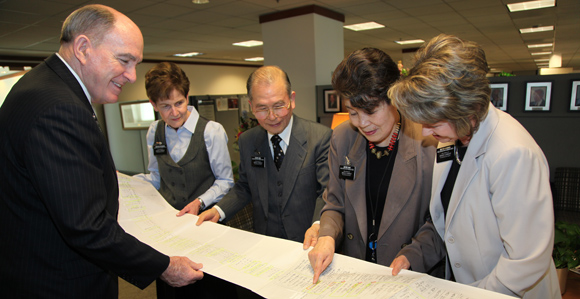
Sister Hiroko Shio and Elder Hideo Shio show a copy of a scroll containing 39 generations of family history to Sister Joan Peterson, President Wayne S. Peterson, and Sister Joanne Karren of the Family and Church History Headquarters Mission.
Article Highlights
- Elder and Sister Shio cataloged a 20-foot long scroll of 39 generations of family members for whom they have done research.
- Elder and Sister Shio are serving their fifth family history mission.
- The Shios are currently translating early U.S. records of Japanese immigrants.
“We have come on our missions to help all Japanese people achieve salvation. There are so many things to do that we have wanted to come on a mission again and again.” —Sister Hiroko Shio, family history missionary
Related Links
“Think of all the people that we have helped to make happy,” Elder Hideo Shio says as he and his wife, Sister Hiroko Shio, unroll a copy of a scroll, more than 20 feet long, that details names and relationships of family members for whom they have done research. The scroll includes hundreds of names and stretches across 39 generations, down to Elder Shio’s grandson.
“I inherited the scroll from my father, a temple worker and stake patriarch who had a keen interest in genealogy,” Elder Shio explains. “I learned from him the importance of family records. I just kept his work going.” Because the Shios are descendents of Kanmu, the 50th emperor of Japan, they have been able to find records that cover centuries of ancestral history. On Elder Shio’s side of the family, that history includes the Taira, Iwaki, and Shio families. (Kanmu, also spelled Kammu, was crown prince of Japan from 773–781, then emperor from 781–806.)
The Shios, who are from Tokyo, are serving for the fifth time in the Family and Church History Headquarters Mission in Salt Lake City, Utah. Their first mission started in June 1999.
“We have come on our missions to help all Japanese people achieve salvation,” Sister Shio says. “There are so many things to do that we have wanted to come on a mission again and again.”
Translating Records
The Shios are currently translating early U.S. records of Japanese immigrants. With this information, Japanese Americans can locate the hometown city hall where their ancestors’ records are housed. Because Japanese vital records are not available online, the only way to find information is to write to the city hall.
Official Japanese records are based on the koseki, or household register. It contains vital information about each household member, including birth, adoption, marriage, divorce, and death dates. Many Japanese city halls are converting records that were written in older, harder-to-read Japanese characters into printed, easier-to-read kanji. But not all information is being included on the updated records, so there is a sense of urgency to obtain records before valuable details are lost.
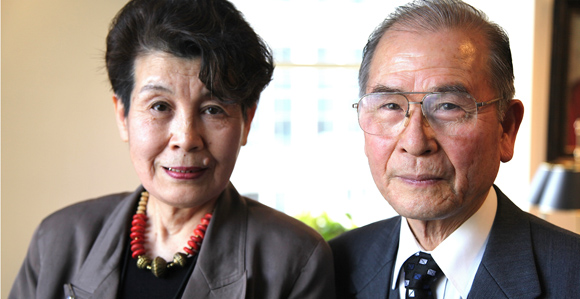
Sister Hiroko Shio and Elder Hideo Shio are serving their fifth family history mission. “There are so many things to do,” Sister Shio says, “that we have wanted to come on a mission again and again.” The Shios are currently translating early U.S. records of Japanese immigrants. Photo by Richard M. Romney, © IRI.
“The Family History Library has wonderful and useful microfilms for those of Japanese ancestry,” says Elder James Sullenger, the Shios’ zone leader, “but unfortunately they are not useable for anyone who cannot understand older, hard-to-read Japanese characters.”
The Shios are reading these microfilms, extracting and indexing valuable information that will then be digitized and searchable in both Japanese and English. This will provide the tools necessary to connect to ancestry records in Japan. Other missionaries are extracting similar information for those who came to the United States from Okinawa.
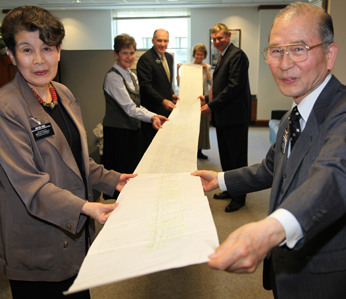
Sister Hiroko Shio (front left) and Elder Hideo Shio (front right) show a copy of a scroll containing 39 generations of family history to Sister Joan Peterson, President Wayne S. Peterson, Sister Joanne Karren, and Elder Gary Karren of the Family and Church History Headquarters Mission. Photo by Richard M. Romney, © IRI.
Opening the Gate
“This information can be the key to opening the gate for many to locate their ancestors,” Elder Sullenger says. “The Family History Library is blessed to have Elder and Sister Shio and others like them. Their work is valuable and important.”
“As we research family history, Heavenly Father blesses us,” Elder Shio says. “He blesses not only ourselves but our children and grandchildren, as well as our ancestors. The Holy Ghost guides us as we work.”
The Shios are among 1,254 full-time and Church-service missionaries in the Family and Church History Headquarters Mission. The mission includes all full-time and Church-service missionaries who serve at Church headquarters, except the sister missionaries who serve on Temple Square.
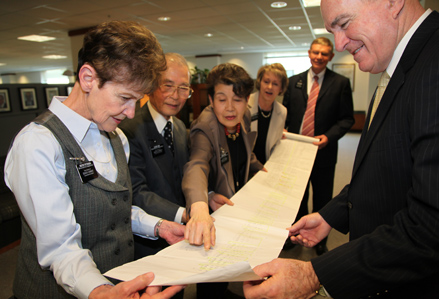
Sister Joan Peterson (left) examines a name pointed out by Elder Hideo Shio and Sister Hiroko Shio (center, pointing) as Sister Joanne Karren, Elder Gary Karren, and President Wayne S. Peterson of the Family and Church History Headquarters Mission look on. Photo by Richard M. Romney, © IRI.
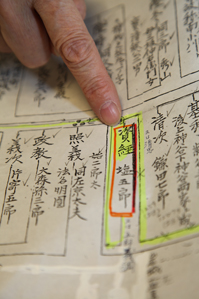
Green highlighting and red ink identify the Shio family name on a photocopy of a record that dates back to 50th emperor of Japan, Kanmu, who reigned from 781 to 806. The record includes names from the Taira, Iwaki, and Shio families. Photo by Richard M. Romney, © IRI.
